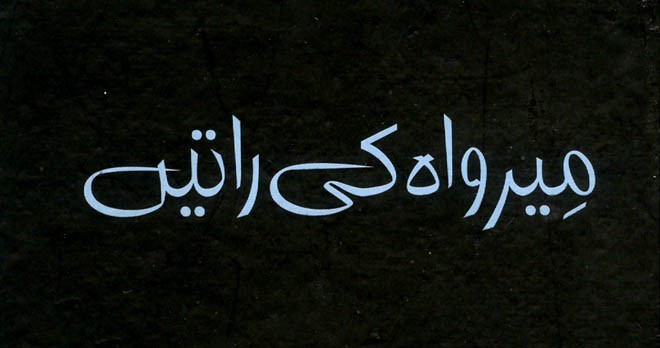
A complex portrait of a society that needs to engage itself in a serious conversation about issues of sexual politics and economic independence

While well-written literary tomes can hit like a hammer, carefully crafted slim volumes often cut like a knife. Rafaqat Hayat’s Mir Wah ki Raateen attempts to achieve the latter. Set in a small, sleepy and insignificant town in interior Sindh, the novel captures an emotional moment in the life of its protagonist, Nazir. He has come to live with his father’s younger brother who is married to a woman half his age and the couple has no kids of their own.
The novel opens with the foreknowledge of two-fold moral tension: sexual attraction to his aunt (his father’s brother’s wife) primarily due to physical proximity; along with sexual attraction to another woman whom he courts during a train journey. As he makes inroads regarding the latter’s whereabouts by befriending a hashish-smoking costermonger, Noorul, he learns that she too is married, albeit unhappily. Having earned Noorul’s trust (read: homosocial code of behaviour) Nazir manages to have several late night trysts with the married woman, Shamim, culminating in a rendezvous at her house but their lovemaking is spoiled when a cat falls on Nazir’s back.
Meanwhile, Nazir’s uncle also grows suspicious, but his wife, Khair-un-Nissa, outwits him with the help of sleeping pills and consummates with Nazir. The novel ends as Nazir experiences a sense of loss after having scored with two women and leaves town.
Having turned the last page, the reader is faced with several questions. Why did the protagonist leave? Why two married women? Is it a love story?
Sexual transgression is not new in modern Urdu fiction despite the coup d’etat by Puritanism. One simply has to recall the two main characters from Bano Qudsia’s Raja Gidh. What is gripping, however, is that Hayat has conjured two intriguing female prototypes. One is at home, within reach, with a carefree clothing attitude that is prone to revealing her breasts and skin whenever chance permits, fully aware that there’s a young, inexperienced audience on hand. Yet she offers prayers five times a day. The second woman, Shamim, equally attracted to Nazir, is burqa-clad when they meet on the train; she is completely covered except for her eyes and hands. She is a daring woman as she manages to rendezvous with Nazir several times at great risk, with the help of Noorul and his wife.
The mise en scène that Hayat has set up probes the sexual excitement and oppressiveness of Pakistani’s semi-urban and semi-rural culture steeped in a lower-middle class and patriarchal power structure.
From a typical male perspective, both women exhibit sexual agency in the service of the male protagonist, who realises that sexual suffocation also results in diminishing one’s ability to love. That’s an interesting critique, even if it was not the author’s intended aim. Perhaps both women embody the two sides of male desire: mysterious and obvious, mystical and physical. Hayat allows women some agency, but it is mostly only sexual agency in a very male-dominated societal structure. The real power stems from economic agency which Hayat shows little interest in exploring. The transgression by both women, while subverting their husbands’ virility, is only in the service of another male. This is an important critique that deserves attention.
In the first few pages, a Sindhi classical poetic work by the title of Momal Rana or Rano by Shah Abdul Latif Bhitai is invoked; it is Nazir’s favourite tale and we are told that he could read it repeatedly, though we never see him reading anything at all except at the opening. This often happens as authors unconsciously turn their characters into their stand in. Such efforts deplete the characters’ complexity. There’s nothing literary about Nazir but that’s fine. He is interesting as he is -- a young, restless man, sorting out his sexual and romantic urges, and in the process explores spaces where his personal freedom to err and learn can take place.
Hayat has carefully put together a language which straddles between the restrained but charged tone of the common man’s speech. But there’s also a minor dissonance, when the pendulum of diction oscillates from dialogues to some words such as saheb-e sarwat or chashm-e tassawari or qabil-e nafreen or azu-e laziz or anzaal, drawing attention away from the candid roughness of the narrative to the narrator’s preference for a highbrow, conservative choice of words. It is a matter of style and craft to use highly symbolic language, for example, when Gustave Flaubert describes a very suggestive scene in Madame Bovary: "A bare hand appeared…threw out some torn scraps of paper. The wind scattered them, and they alighted at a distance like white butterflies…" But to describe a crucial scene where Nazir sits by the cold water of a small river and in a state of anger wants to release sexual tension burdened by puritan modesty, the usage of such language suggests the author’s unwillingness to disrupt the culture police’s comfort zone.
There are moments in literature which require direct, honest words representing real communication between the author and his characters. It is my hope that the new generation of Urdu writers can claim the language as it is spoken not only inside the highly educated minds but on the tongues of people who actually give language its spark and pizzazz. It is also unfair to love characters belonging to the lower depths while according them the language of the ashrafia.
These are minor criticisms of Mir Wah ki Raateen, a complex portrait of a society that needs to engage itself in a serious conversation about issues of sexual politics and economic independence. I hope the book is widely read and discussed.